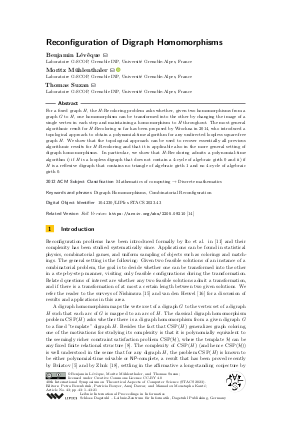Reconfiguration of Digraph Homomorphisms
Authors
Benjamin Lévêque,
Moritz Mühlenthaler  ,
Thomas Suzan
,
Thomas Suzan
-
Part of:
Volume:
40th International Symposium on Theoretical Aspects of Computer Science (STACS 2023)
Part of: Series: Leibniz International Proceedings in Informatics (LIPIcs)
Part of: Conference: Symposium on Theoretical Aspects of Computer Science (STACS) - License:
 Creative Commons Attribution 4.0 International license
Creative Commons Attribution 4.0 International license
- Publication Date: 2023-03-03
File

PDF
LIPIcs.STACS.2023.43.pdf
- Filesize: 0.88 MB
- 21 pages
Document Identifiers
Related Versions
- Full Version https://arxiv.org/abs/2205.09210
Subject Classification
ACM Subject Classification
- Mathematics of computing → Discrete mathematics
Keywords
- Digraph Homomorphisms
- Combinatorial Reconfiguration
Metrics
- Access Statistics
-
Total Accesses (updated on a weekly basis)
0Document
0Metadata
Abstract
For a fixed graph H, the H-Recoloring problem asks whether, given two homomorphisms from a graph G to H, one homomorphism can be transformed into the other by changing the image of a single vertex in each step and maintaining a homomorphism to H throughout. The most general algorithmic result for H-Recoloring so far has been proposed by Wrochna in 2014, who introduced a topological approach to obtain a polynomial-time algorithm for any undirected loopless square-free graph H. We show that the topological approach can be used to recover essentially all previous algorithmic results for H-Recoloring and that it is applicable also in the more general setting of digraph homomorphisms. In particular, we show that H-Recoloring admits a polynomial-time algorithm i) if H is a loopless digraph that does not contain a 4-cycle of algebraic girth 0 and ii) if H is a reflexive digraph that contains no triangle of algebraic girth 1 and no 4-cycle of algebraic girth 0.
Cite As Get BibTex
Benjamin Lévêque, Moritz Mühlenthaler, and Thomas Suzan. Reconfiguration of Digraph Homomorphisms. In 40th International Symposium on Theoretical Aspects of Computer Science (STACS 2023). Leibniz International Proceedings in Informatics (LIPIcs), Volume 254, pp. 43:1-43:21, Schloss Dagstuhl – Leibniz-Zentrum für Informatik (2023)
https://doi.org/10.4230/LIPIcs.STACS.2023.43
BibTex
@InProceedings{leveque_et_al:LIPIcs.STACS.2023.43,
author = {L\'{e}v\^{e}que, Benjamin and M\"{u}hlenthaler, Moritz and Suzan, Thomas},
title = {{Reconfiguration of Digraph Homomorphisms}},
booktitle = {40th International Symposium on Theoretical Aspects of Computer Science (STACS 2023)},
pages = {43:1--43:21},
series = {Leibniz International Proceedings in Informatics (LIPIcs)},
ISBN = {978-3-95977-266-2},
ISSN = {1868-8969},
year = {2023},
volume = {254},
editor = {Berenbrink, Petra and Bouyer, Patricia and Dawar, Anuj and Kant\'{e}, Mamadou Moustapha},
publisher = {Schloss Dagstuhl -- Leibniz-Zentrum f{\"u}r Informatik},
address = {Dagstuhl, Germany},
URL = {https://drops.dagstuhl.de/entities/document/10.4230/LIPIcs.STACS.2023.43},
URN = {urn:nbn:de:0030-drops-176958},
doi = {10.4230/LIPIcs.STACS.2023.43},
annote = {Keywords: Digraph Homomorphisms, Combinatorial Reconfiguration}
}
Author Details
References
- Paul Bonsma and Luis Cereceda. Finding paths between graph colourings: PSPACE-completeness and superpolynomial distances. Theoretical Computer Science, 410(50):5215-5226, 2009. URL: https://doi.org/10.1016/j.tcs.2009.08.023.
-
Richard C Brewster, Jae-Baek Lee, and Mark H Siggers. Recoloring reflexive digraphs. Discrete Mathematics, 341(6):1708-1721, 2018.

- Richard C Brewster, Jae-Baek Lee, and Mark H Siggers. Reconfiguration of homomorphisms to reflexive digraph cycles. Discrete Mathematics, 344(8):112441, 2021. URL: https://doi.org/10.1016/j.disc.2021.112441.
- Richard C Brewster, Sean McGuinness, Benjamin Moore, and Jonathan A Noel. A dichotomy theorem for circular colouring reconfiguration. Theor. Comput. Sci., 639:1-13, 2016. URL: https://doi.org/10.1016/j.tcs.2016.05.015.
-
Andrei A Bulatov. A dichotomy theorem for nonuniform CSPs. In IEEE 58th Annual Symposium on Foundations of Computer Science (FOCS), pages 319-330. IEEE, 2017.

- Luis Cereceda, Jan van den Heuvel, and Matthew Johnson. Finding paths between 3-colorings. Journal of Graph Theory, 67(1):69-82, 2011. URL: https://doi.org/10.1002/jgt.20514.
- Anton Dochtermann and Anurag Singh. Homomorphism complexes, reconfiguration, and homotopy for directed graphs, 2021. URL: https://doi.org/10.48550/arXiv.2108.10948.
- Tomás Feder and Moshe Y Vardi. The computational structure of monotone monadic SNP and constraint satisfaction: A study through datalog and group theory. SIAM J. Comput., 28(1):57-104, 1998. URL: https://doi.org/10.1137/S0097539794266766.
- Parikshit Gopalan, Phokion G Kolaitis, Elitza N Maneva, and Christos H Papadimitriou. The connectivity of boolean satisfiability: Computational and structural dichotomies. SIAM J. Comput., 38(6):2330-2355, 2009. URL: https://doi.org/10.1137/07070440X.
- Tesshu Hanaka, Takehiro Ito, Haruka Mizuta, Benjamin Moore, Naomi Nishimura, Vijay Subramanya, Akira Suzuki, and Krishna Vaidyanathan. Reconfiguring spanning and induced subgraphs. Theor. Comput. Sci., 806:553-566, 2020. URL: https://doi.org/10.1016/j.tcs.2019.09.018.
- Takehiro Ito, Erik D Demaine, Nicholas JA Harvey, Christos H Papadimitriou, Martha Sideri, Ryuhei Uehara, and Yushi Uno. On the complexity of reconfiguration problems. Theoretical Computer Science, 412(12–14):1054-1065, 2011. URL: https://doi.org/10.1016/j.tcs.2010.12.005.
- Jae-Baek Lee, Jonathan A Noel, and Mark H Siggers. Reconfiguring graph homomorphisms on the sphere. Eur. J. Comb., 86:103086, 2020. URL: https://doi.org/10.1016/j.ejc.2020.103086.
-
Jae-Baek Lee, Jonathan A Noel, and Mark H Siggers. Recolouring homomorphisms to triangle-free reflexive graphs. Journal of Algebraic Combinatorics, pages 1-21, 2022.

- Benjamin Lévêque, Moritz Mühlenthaler, and Thomas Suzan. Reconfiguration of digraph homomorphisms. CoRR, abs/2205.09210, 2022. URL: https://doi.org/10.48550/arXiv.2205.09210.
-
Naomi Nishimura. Introduction to reconfiguration. Algorithms, 11(4):52, 2018.

-
Jan van den Heuvel. The complexity of change. In Simon R Blackburn, Stefanie Gerke, and Mark Wildon, editors, Surveys in Combinatorics 2013, volume 409. London Mathematical Society Lectures Note Series, 2013.

- Marcin Wrochna. Homomorphism reconfiguration via homotopy. SIAM J. Discret. Math., 34(1):328-350, 2020. URL: https://doi.org/10.1137/17M1122578.
-
Dmitriy Zhuk. A proof of the CSP dichotomy conjecture. Journal of the ACM, 67(5):1-78, 2020.

